
Return to Flint and stone axes from Thanet
Display Contents
Flint and stone axes from Thanet
Link -
Thanet axes - a review
Ring-ditches
Reworking
Ceremonial axes?
Surface finds
Non-flint axes
Artefact scales in centimetre divisions
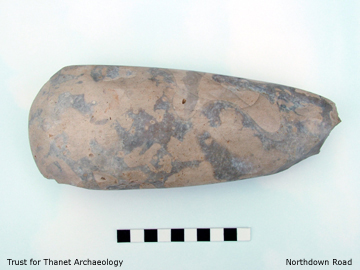
Thanet axes - a review
The
majority of Thanet's polished axes are fully functional tools which
have been well used. Generally these objects are also seen as
prestigious items who's degree of craftsmanship present in their
manufacture gives them a status beyond their practical function.
How
true this view is might depend on where
we discover these objects today. That can at least give an indication
on how
they were viewed at the time of their disposal.
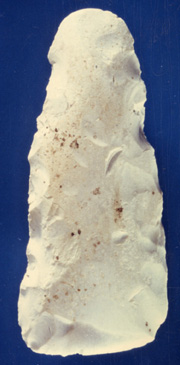
The Ebbsfleet axe
Photographer unknown
Four of Thanet's polished flint axes (three of which are complete) have been found in ring-ditch monuments and roundbarrows. The examples from Ebbsfleet (pictured left) and North Foreland (pictured below) were found redeposited in the ditches. A fragment was also discovered in the outer ditch at Lord of the Manor I (recut in the Beaker Period). Another was found at Lord of the Manor III (pictured further below). The precise context of this piece is uncertain at present.
The
final deposition of the
Ebbsfleet and North Foreland axes may have been the
result of an
intentional act inspired by the monument themselves. Both are very
strongly patinated however, which suggests that they have had a
significant period of surface exposure.
In the
case of the North
Foreland example at least (pictured below) this was prior to
its final burial in the
primary fill of the barrow ditch. The position may suggest that its
deposition was contemporary with the completion of the Beaker burial
and could be viewed as a devotional or ritual act.
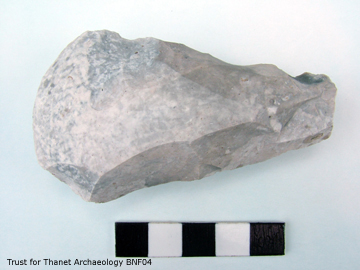
However it
should be noted
that the backfill of the Beaker grave also contained Early Neolithic
flints of similar though slightly stronger patination. This suggests
that residual occupation debris was disturbed during the construction
of the barrow monument.
The axe could have been
encountered at this
time and was put aside for deposition in the ditch, or just discarded
onto the chalk spoil upcast, to swiftly erode into the ditch with the
primary silting.
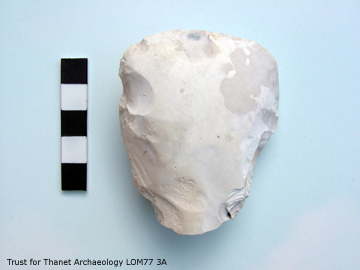
The recovery of the axes was then either very fortunate, or may suggest that the ditches may have been the focus of more widespread depositional activity associated with the monuments.
At least two of Thanet's polished flint axes show a significant amount of reworking. It can be clearly seen on the examples from North Foreland and St. Peter's footpath. The reworking has been done to re-shape and thin the body of the axes so they can be fixed into new hafts.
This action has significantly altered
the aesthetic appearance of the
axes and destroyed their status-value as anything other than practical
tools. This may demonstrate that the importance of the practical use of
such tools ultimately outweighed their status-value, at least late in
their life.
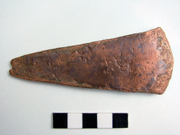
An early metal axe
from Gore End, Birchington
With the advent of the Beaker Period and the Early Bronze Age, metal axes arrived and gained prestige at the expense of the stone ones. However these early metal axes were initially in short supply and some polished axes were still held in high regard. Others were made to imitate the splayed blades of the early metal axes.
This period saw the production of impractically large polished axes which remained unused as tools and likely functioned as status symbols, objects of gift-exchange or implements associated with ritual activity.
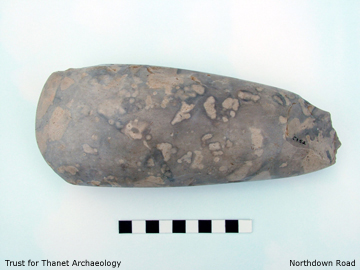
At least two of Thanet’s axes have appeared as surface finds. One was found along the St.Peter’s footpath (pictured below). Another was retrieved from the ploughsoil at Netherhale Farm. The Stone House axe may have been recovered from a similar topsoil or subsoil context.
It has been observed
elsewhere that many polished axes are
discovered as ploughsoil finds. This may suggest that they have been
ploughed out of shallow features. Another idea is that these tools
could also have been used as hoes and were lost in ancient ploughsoils
by Neolithic farmers.
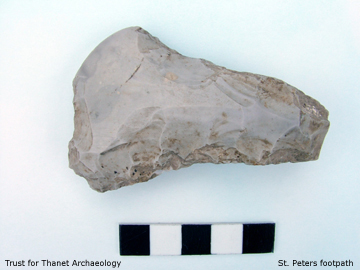
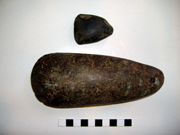
Non-local polished stone axes
From the collection of
Mike Child
The excavations along the Monkton-Minster A253 and at the Earlier Neolithic Causewayed Enclosure at Chalk Hill, Chilton (both by Canterbury Archaeological Trust) have produced the only evidence for the use of non-flint axes on the Isle. In both cases only fragments have been recovered (and the precise nature of the Monkton-Minster axe is uncertain at present).
Bradley (1984) suggests that stone axes
seemed to have been preferred
to flint by the users of Late Neolithic Grooved Ware. On Thanet there
is currently very little evidence for both the use of Grooved Ware and
stone axes.
The piece from the Chilton site was
identified as being from a Group
VI axe (an Implement Petrology Group classification). The raw
material is a Tuff which comes from the highly productive 'axe factory'
at Great Langdale in Cumbria. Group VI axes are probably the most
numerous
type found in Britain.
In Wessex these are typically found in assemblages associated with Peterborough Ware pottery (Thorpe and Richards 1984). This is a Mid (and possibly Late) Neolithic pot form who's use overlaps with the end of the Earlier Neolithic.
In Wessex these are typically found in assemblages associated with Peterborough Ware pottery (Thorpe and Richards 1984). This is a Mid (and possibly Late) Neolithic pot form who's use overlaps with the end of the Earlier Neolithic.
In the South East it is the Group I
class of stone axes which occur
most frequently. These are of Greenstone and likely to originate from
the South West; some from the Mounts Bay area
of Cornwall (perhaps from a site now submerged). By 2002 there were 8
examples
known from Kent, none found in East Kent (Lewis and Parfitt 2002).
Both Group I and Group VI
axes were manufactured and used over a relatively long period of time
(Smith 1979).
The
current count of flint and stone axes is no doubt less than
the true figure of those recovered so far. Further research should increase the quantity and accuracy of this
figure.
A greater knowledge of the
context of their discovery
will also prove vital in an understanding of the role played by these
prestigious objects during the Neolithic.
If you have any
extra information regarding Thanet’s
flint and stone axes please get in touch.
Version 1 - Posted 27.07.06
Version 2 - Posted 16.12.06
All
content © Trust for Thanet Archaeology